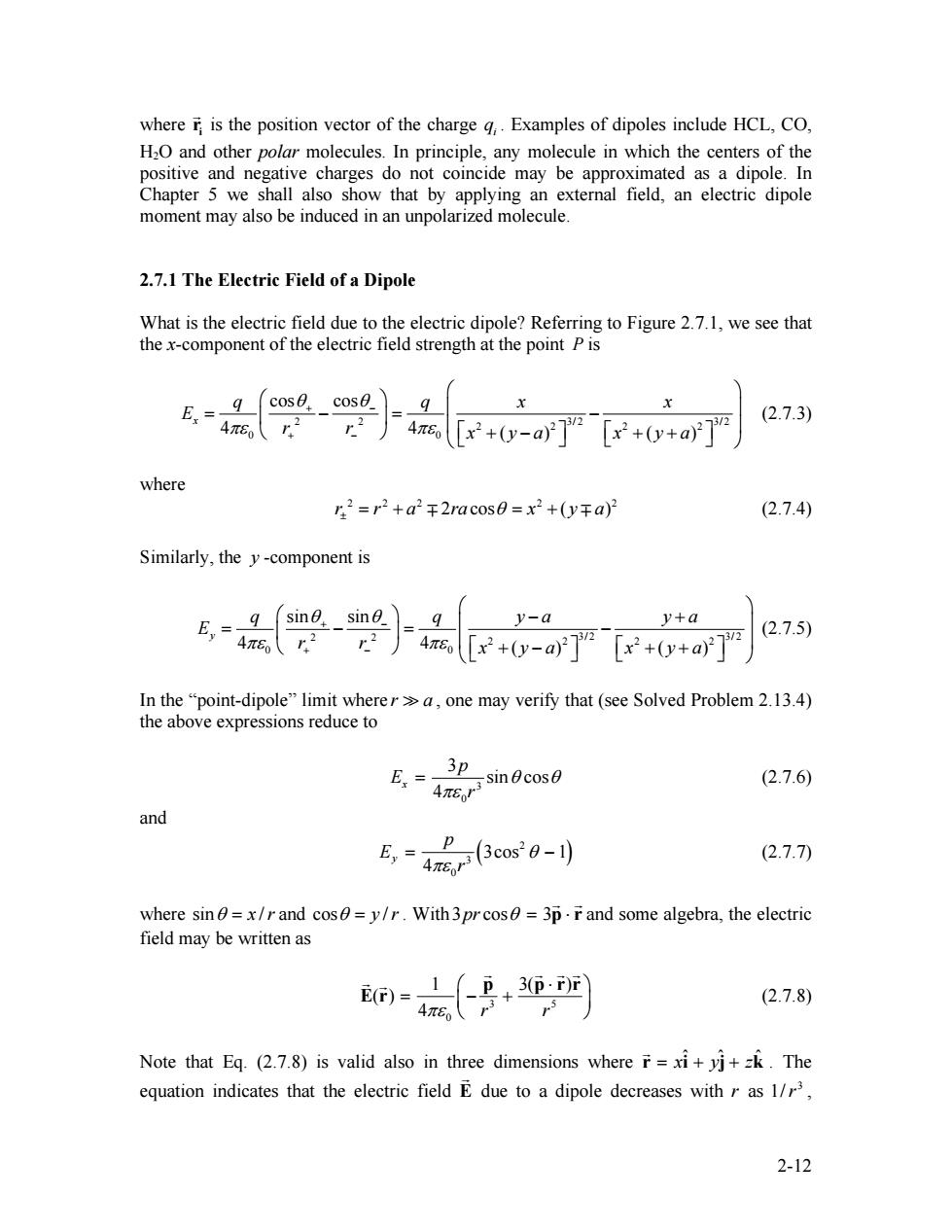正在加载图片...

where r is the position vector of the charge g,.Examples of dipoles include HCL,CO, H2O and other polar molecules.In principle,any molecule in which the centers of the positive and negative charges do not coincide may be approximated as a dipole.In Chapter 5 we shall also show that by applying an external field,an electric dipole moment may also be induced in an unpolarized molecule. 2.7.1 The Electric Field of a Dipole What is the electric field due to the electric dipole?Referring to Figure 2.7.1,we see that the x-component of the electric field strength at the point P is E 女 +0-a[+0+a严 (2.7.3) where r2=r2+a22racos0=x2+(ya)2 (2.7.4) Similarly,the y-component is q sine sine E,1 y-a y+a 2 [r+0-a2[x+0+ar] (2.7.5) TEo 4πe0 In the "point-dipole"limit wherera,one may verify that (see Solved Problem 2.13.4) the above expressions reduce to insinocoso ,3p (2.7.6) and E(c1) (2.7.7) where sin=x/r and cos=y/r.With3prcos 3p.r and some algebra,the electric field may be written as )=( +3p加 4π6r3 (2.7.8) Note that Eq.(2.7.8)is valid also in three dimensions where r=xi+yj+k.The equation indicates that the electric field E due to a dipole decreases with r as 1/r3, 2-12where is the position vector of the charge . Examples of dipoles include HCL, CO, H i r G i q 2O and other polar molecules. In principle, any molecule in which the centers of the positive and negative charges do not coincide may be approximated as a dipole. In Chapter 5 we shall also show that by applying an external field, an electric dipole moment may also be induced in an unpolarized molecule. 2.7.1 The Electric Field of a Dipole What is the electric field due to the electric dipole? Referring to Figure 2.7.1, we see that the x-component of the electric field strength at the point P is 2 2 3/ 2 3/ 2 2 2 2 2 0 0 cos cos 4 4 ( ) ( ) x q q x E r r x y a x y a θ θ πε πε + − + − ⎛ ⎞ ⎛ ⎞ = − ⎜ ⎟ = ⎜ ⎟ − ⎝ ⎠ ⎡ ⎤ + − ⎡ + + ⎝ ⎠ ⎣ ⎦ ⎣ x ⎤ ⎦ 2 ∓ (2.7.3) where (2.7.4) 2 2 2 2 r r a 2 c ra osθ x ( y a) ± = + ∓ = + Similarly, the y -component is 2 2 3/ 2 3/ 2 2 2 2 2 0 0 sin sin 4 4 ( ) ( ) y q q y a y E r r x y a x y a θ θ πε πε + − + − ⎛ ⎞ ⎛ ⎞ − + = − ⎜ ⎟ = ⎜ ⎟ − ⎝ ⎠ ⎡ ⎤ + − ⎡ + + ⎝ ⎠ ⎣ ⎦ ⎣ a ⎤ ⎦ (2.7.5) In the “point-dipole” limit where , one may verify that (see Solved Problem 2.13.4) the above expressions reduce to r a 3 0 3 sin cos 4 x p E r θ θ πε = (2.7.6) and ( 2 3 0 3cos 1 4 y p E r θ πε = − ) (2.7.7) where sinθ = x /r and cosθ = y /r. With3pr cosθ = 3p ⋅ r G G and some algebra, the electric field may be written as 3 5 0 1 3( ( ) 4πε r r ⎛ ⋅ = −⎜ + ⎝ ⎠ p p r r E r ) ⎞ ⎟ G G G G G G (2.7.8) Note that Eq. (2.7.8) is valid also in three dimensions where ˆ ˆ ˆ r i = + x yj + zk G . The equation indicates that the electric field E G due to a dipole decreases with r as , 3 1/r 2-12